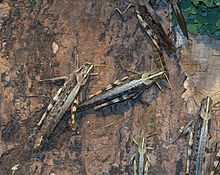Schistocerca nitens
| Schistocerca nitens | |
|---|---|
 | |
| Conservation status | |
| Scientific classification | |
| Kingdom: | Animalia |
| Phylum: | Arthropoda |
| Class: | Insecta |
| Order: | Orthoptera |
| Suborder: | Caelifera |
| Family: | Acrididae |
| Genus: | Schistocerca |
| Species: | S. nitens |
| Binomial name | |
| Schistocerca nitens Thunberg, 1815 | |
| Synonyms | |
|
Schistocerca vaga | |
Schistocerca nitens is a species of grasshopper known by several common names, including vagrant grasshopper and gray bird grasshopper. It is a close relative of the desert locust, which is in the same genus. This grasshopper is native to southern North America including Mexico and the southwestern United States from California to Texas. It is also present in parts of Central America. It lives in many habitats including desert, woodland, and lower elevation mountainous areas. It is a large grasshopper, reaching lengths of 4 to 7 centimeters. It is mostly brown and gray spotted or patched in cryptic coloration. This species is known as a pest on ornamental plants and many types of crop plants.
Hawaiian population
It is a troublesome invasive species in Hawaii. This grasshopper is usually solitary, but it has been known to swarm as locusts. A particularly destructive swarming event occurred on the Hawaiian island of Nihoa in 2004, wiping out some 90% of the vegetation on the island.[1] It was probably introduced to Hawaii several decades ago and then spread through the archipelago by flying; it has the ability to fly at least 300 miles across ocean.[1]
Life cycle
The grasshopper becomes sexually mature at 3 to 4 months of age. Any stage of its life cycle can be seen at any time of the year, but the adult is less active during the winter and fall. Mating usually occurs on warm nights in summer, and often around bright lights.
References
- ↑ 1.0 1.1 Lockwood, J. A. & A. V. Latchininsky. (2008). Confessions of a Hit Man. Conservation Magazine 9:3.
